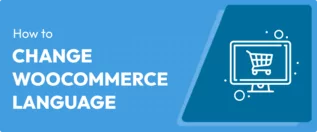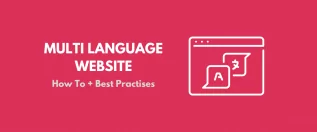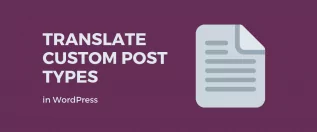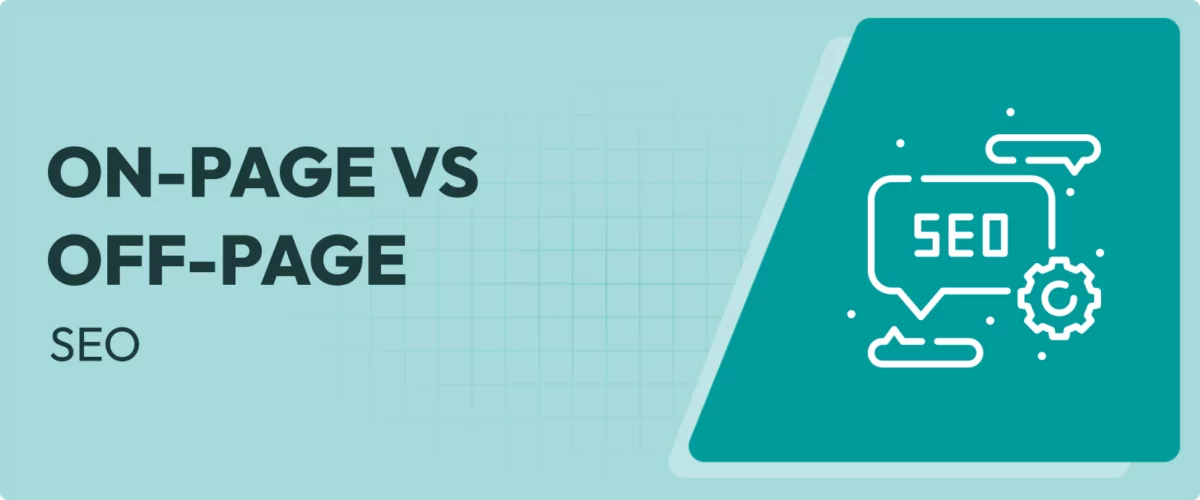
In this post
Wondering what are on-page vs. off-page SEO?
Search Engine Optimization (SEO) is a critical strategy for online businesses and websites, as it helps drive organic traffic to the website by improving visibility in search engine results pages (SERPs).
At its core, SEO comprises two fundamental components: on-page and off-page optimization.
While both components aim to improve a website’s search engine rankings, they focus on distinct aspects of optimization.
On-page SEO revolves around factors within a website’s control, such as content quality, keyword optimization, internal linking structure, etc.
In contrast, off-page SEO addresses external factors that influence a site’s authority and credibility like backlink profiles, social signals, brand mentions, and online reputations, among other things.
Understanding the nuances between on-page and off-page SEO is crucial for developing a comprehensive search engine optimization strategy.
In this article, we have delved into the key elements of both approaches, exploring how they contribute to improved SERP visibility when combined.
Let’s dive in.
On-Page SEO: Components + Impact on SERP Visibility
On-page SEO refers to the optimizations made within a website to boost its ranking chances in the SERP.
Let’s look at the different components of on-page SEO and find out how optimizing these components can cause your website to rank better on search engine result pages.
1. Content Quality
Content quality is one of the most important factors search engines consider when evaluating a website for ranking.
Content that covers the topic well, uses clear, concise language, addresses the search intent, incorporates keywords, includes relevant internal and external links, and is well-presented with subheadings, bullet points, and multimedia like images, videos, and gifs, are considered high-quality content.
2. Keywords
Keywords are words or phrases that users type in the search engine to get answers to their queries. For instance, users will type the phrase “website security” into the search engine to learn how to secure their websites.
So if you were to write an article about securing a website, then using the primary keyword “website security” throughout the article is necessary.
Besides that, it’s important to identify closely related keywords, also called secondary keywords, (like “website security checks,” “website security services,” “website security tools,” etc) and include them in the content.
Some of these secondary keywords need to be expanded with dedicated sections. For instance, in a “website security” article, you may need to recommend “top 3 website security tools,” for users to add to their websites to ensure security from hack attacks.
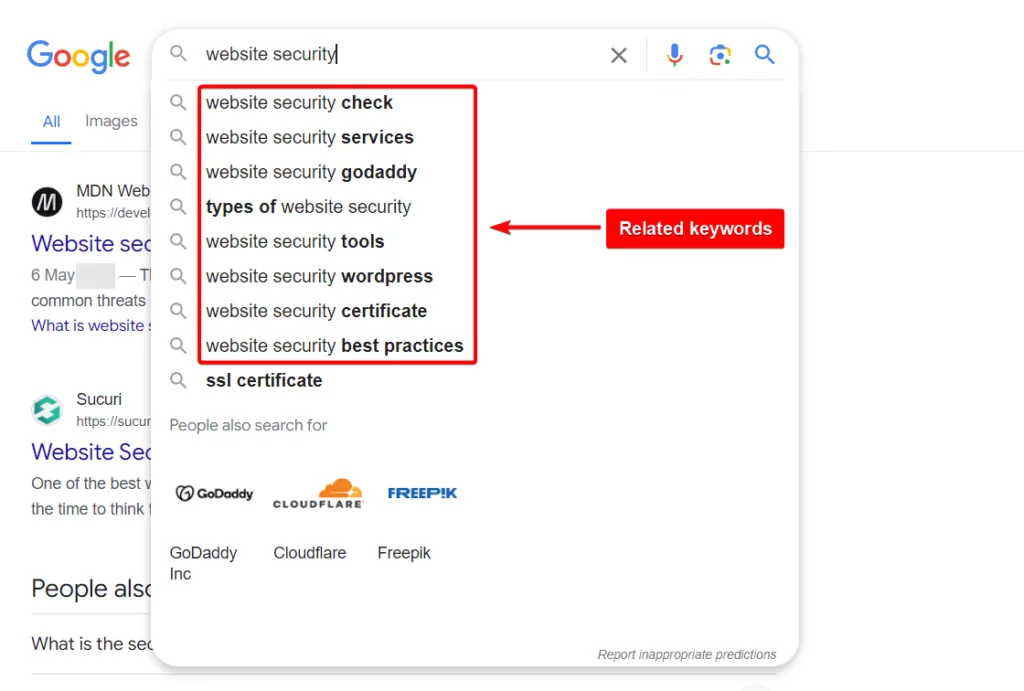
The goal of adding primary and secondary keywords is to increase the relevance of the content (i.e. an article on how to secure a website) with the search query (i.e. “website security”).
Relevant keywords make it easy for search engines to identify what the content is about, and whether it covers the topic well and addresses the search intent properly. It helps the search engine decide whether the content deserves to rank well in the SERP.
3. Multimedia
Websites contain multimedia ranging from images to videos, gifs, audio clips, charts, and infographics.
It’s important to optimize multimedia displayed on the website. Optimization ensures that users and search engines find the multimedia valuable and relevant to the content.
Essential multimedia optimization steps include adding descriptive and keyword-rich titles, alt text, and captions, and tailoring and compressing the size of the multimedia.
4. Slug
A slug is a part of the URL that identifies a webpage or a multimedia file.
For instance, consider this URL of a webpage: https://example.com/website-security/
- “https://” is an encryption protocol
- “example.com” is the domain name
- And “website-security” is the slug
The encryption protocol and domain name are consistent and unchangeable but slugs are unique and can be changed by editing a page.
Slug optimization is an important part of SEO because the slug is one of the first few components of a web page that users and search engines encounter.
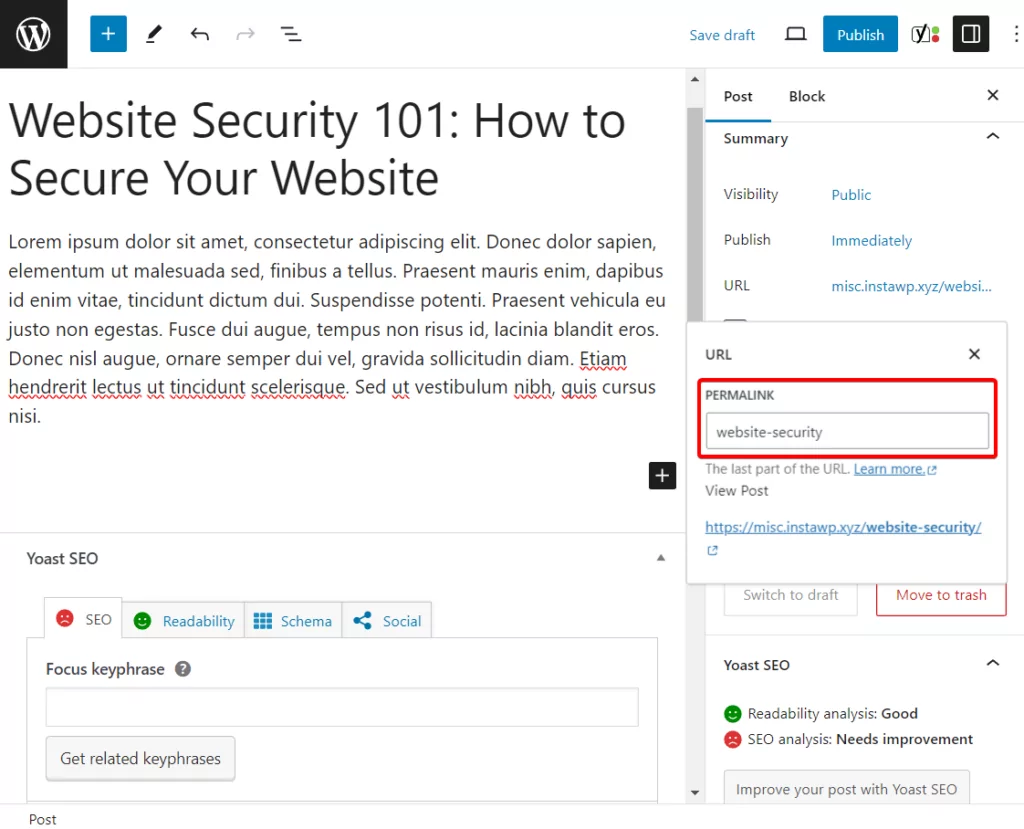
When you properly optimize a slug it becomes short, focused, keyword-rich, and readable, as shown in the example below:
- Non-optimized URL – https://example.com/website-security-101-step-by-step-guide/
- Search engine optimized URL – https://example.com/website-security/ or https://example.com/website-security-guide/.
5. Title Tags
A title tag is an HTML element that specifies the title of a webpage to search engine crawlers.
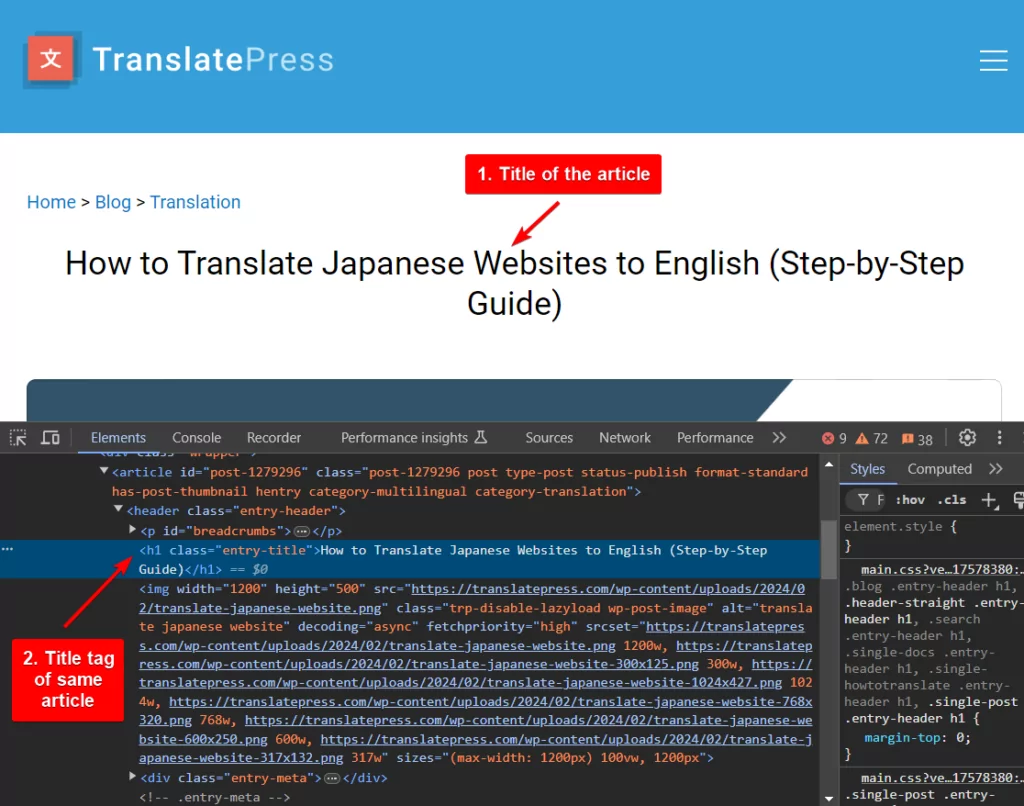
Search engines read the title tag of a webpage to understand what the page is about and whether the page is relevant to the user query and should be ranked in the SERP.
Let’s say, someone’s searching for “translate japanese websites to english” on a search engine.
You recently published an article on the same topic.
While crawling your website, the search engine encounters the following title tag: How to Translate Japanese Websites into English.
The search engine now knows that the webpage is relevant to the query “translate japanese websites to english” and may decide to rank the article in the SERP.
The title tag also appears on the SERP which dictates whether a user will open the link to read the article.
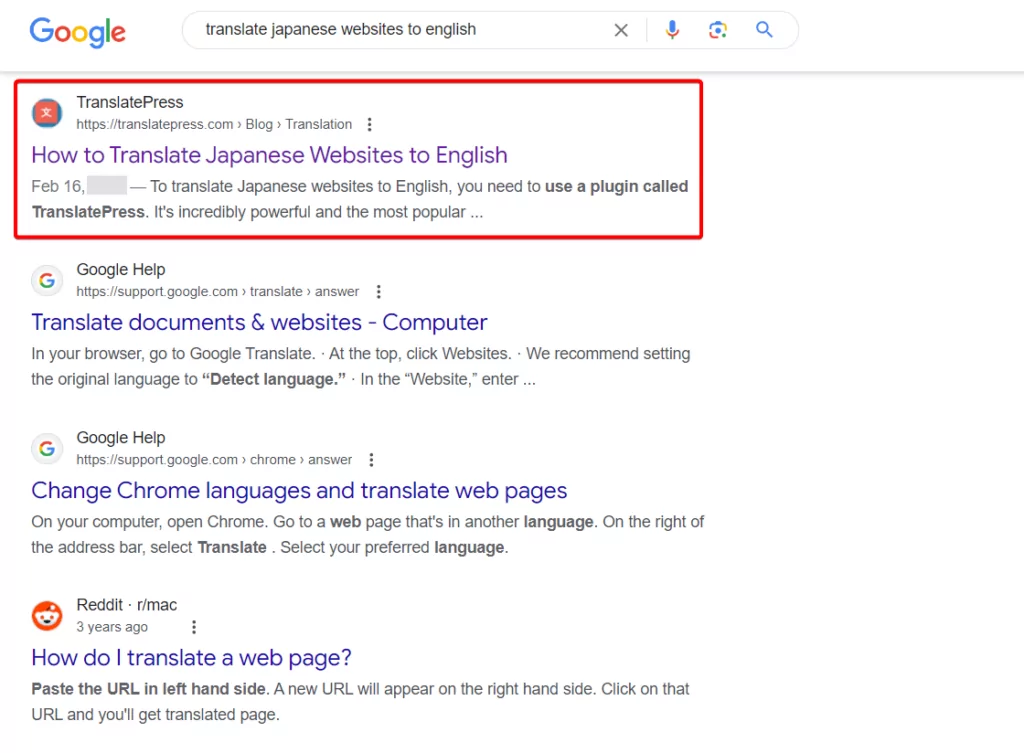
Websites using SEO tools like Yoast SEO and RankMath automatically generate the title tag based on the title of your webpage (also called H1 heading). So when writing the title for a webpage, consider how the title tag will appear to search engine crawlers and users in the SERP.
Some common rules of thumb for writing good title tags/webpage titles are
- Add the primary keyword at the beginning so that both crawlers and users can immediately understand what the web page is about
- Make it short but descriptive so that it fits in the SERP and is easy to read
6. Meta Description Tags
Like the title tags, meta descriptions are also HTML elements. They provide a brief summary of a webpage to help the search engine and users understand what the article is about.
Although search engines automatically pick a piece of content from within the website to display as the meta description on the SERP, they don’t always make the right choice. Therefore SEO experts strongly recommend using SEO tools like Yoast and RankMath to add customized meta descriptions to a webpage.
When writing a meta description for a webpage, follow these rules: keep it under 155 characters, use active voice, add the primary keyword, and include a call-to-action.
7. Internal & External Links
As you may already know, links help connect two pages.
Internal links point to pages within your website and external links point to other websites.
Both types of links are included to add useful resources to the content of a webpage.
For instance, in the introduction of this article, we added the internal link (i.e. https://translatepress.com/seo-for-new-websites/) to the anchor text “search engine optimization strategy” so that the user can easily navigate to that article and learn about SEO strategies.
Internal links also help search engines discover new content on your website.
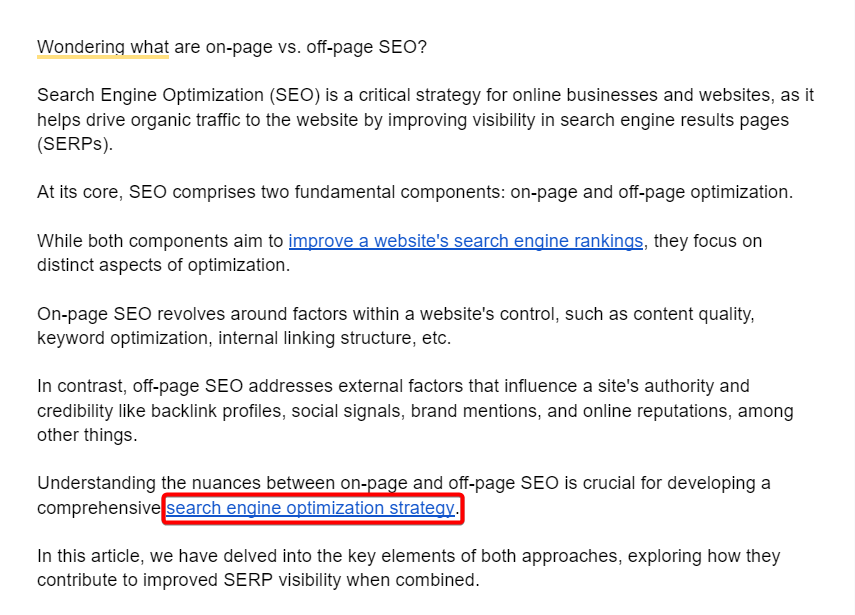
External links send users to other websites to learn about relevant topics.
Take for instance technical SEO. It’s related to search engine optimization but isn’t part of on-page or off-page SEO, so it can’t be included in the article. Since we don’t have a guide on the topic published on our website, users can learn about it from an external website.
A webpage containing many links (internal and external) signals that the website wants to satisfy the user’s search intent. This can convince the search engine to rank your content higher in the SERP.
Be sure to add external links from reputed websites as it demonstrates your intent to offer the best resources to users. It helps search engines trust your website.
8. Multilingual SEO
Multilingual SEO is the process of optimizing your website to be visible in search engines in multiple languages.
Websites implement multilingual on-page SEO when they want to or are already drawing traffic from multiple counties where the native languages differ from your default website language.
Implementing SEO in multiple languages requires time, effort, and access to the right tools. We have built the world’s most powerful and user-friendly plugin for WordPress websites: TranslatePress.
TranslatePress Multilingual
It allows you to implement multilingual SEO without hassle. Read more: How to implement multilingual SEO.
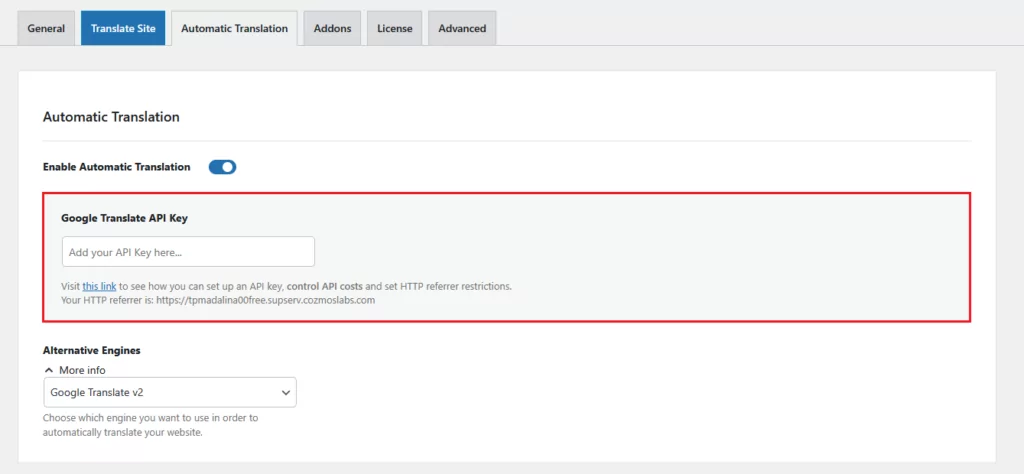
9. Other On-Page SEO Components
Other on-page SEO components that websites should implement are schema markup, page speed, and mobile-friendliness.
These components are just as important as the others but diving into them in detail is beyond the scope of this article. Take a look at the following brief summary for each component:
Schema markup is a code added to your webpage to help search engines better understand the information on the page. Search engines like Google use schema markup data to display your content in the SERP in a rich format.
You can add schema markups to your website using SEO tools like Yoast and RankMath.
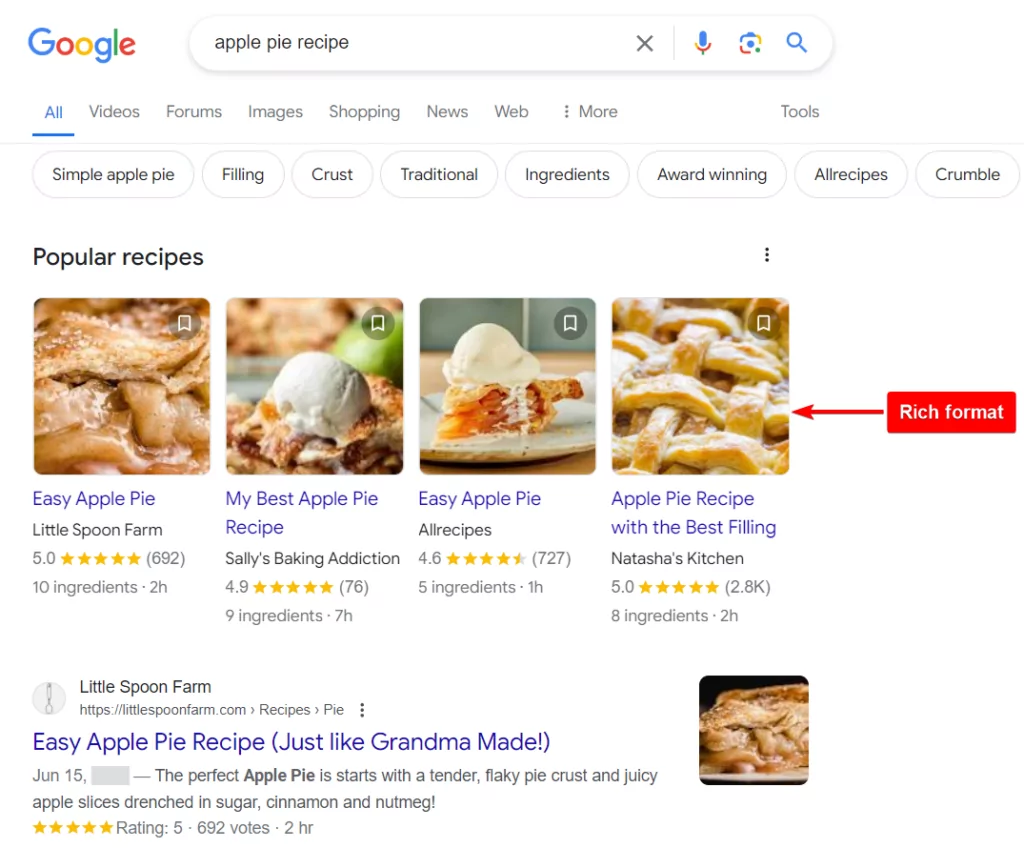
Search engines want to help users get what they want quickly. Therefore they prefer ranking websites with fasting loading speeds.
Some search engines like Google want you to prioritize mobile loading speed because mobile phones are the primary devices used to access the internet nowadays.
To improve mobile loading speed you can choose fast hosting servers, compress images, reduce redirects, cache web pages, reduce plugin installs, etc.
Off-Page SEO: Component + Impact on SERP Visibility
Off-page SEO refers to the optimizations made outside a website to boost its ranking chances in the SERP.
Let’s look at the different components of off-page SEO and find out how optimizing these components will get users and search engines to see your website as trustworthy and authoritative.
With time this will help increase your site’s search engine visibility, increase website traffic, generate leads, and drive sales.
1. Backlinks
Backlinks are links acquired from other websites, either naturally or by manually reaching out to the website.
Websites typically link to exceptional content, service, or product pages.
Search engines consider pages that acquire many backlinks from authority websites as valuable and often rank these pages higher in the SERP.
Numerous pages receiving high-quality backlinks indicate that your website produces exceptional content, or offers great services or products. This makes your website trustworthy in the eyes of search engines and over time helps establish your website as an authority site.
2. Unlinked Mentions or Citations
Positive mentions of your business or website on authoritative and relevant places online, be it forums, social media, other websites, etc, contribute to the search engine’s perception of your business.
List your business on popular directories in your local area and industry, big data aggregators like Foursquare, and local business listing platforms like Apple Maps, Yelp, Bing Places, etc.
Also, consider collaborating with established influencers in your industry to expand your user base, get more mentions, and amplify your brand value through associations.
Hosting digital events is also a great way to grab eyeballs from new users and earn brand mentions.
Other ways to increase mentions are publishing press releases, submitting quotes to expert roundup articles, getting interviewed, and creating appealing visuals that other websites would want to use.
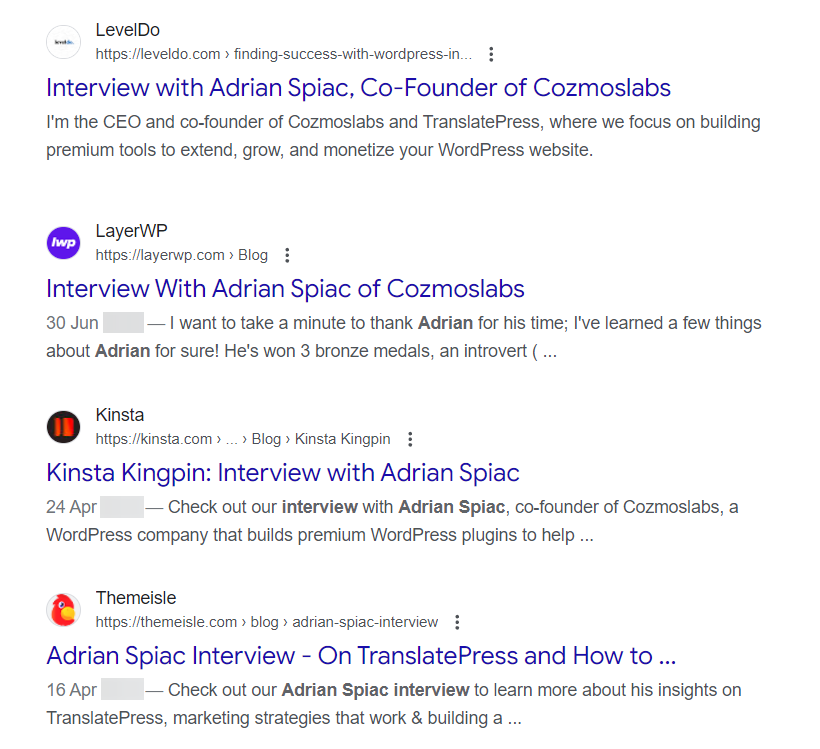
3. Social Media
Social media allows you to draw attention to your business causing brand searches on search engines. This not only helps draw more traffic to your website but also signals search engines about the rising popularity of your business. It helps build trust.
These days search engines like Google display the latest tweets from X within the search engine result pages as an answer to certain queries. Users clicking through those tweets make a positive impression on search engines about your business.
Also, acquiring many organic followers and regularly engaging with them presents you as an approachable and trustworthy business.
4. Reviews, Ratings & Awards
People leave reviews and ratings on services and products they have used. These reviews and ratings help potential users decide whether to use the service or product.
Awards, handed out by authorities in the industry, are important for blogs and media sites as they don’t rely on reviews and ratings.
Like users, search engines also consider reviews, ratings, and awards to judge the value of a website.
Prestigious awards or positive reviews and ratings help establish trust and improve a website’s ranking in the SERP.
Conclusion
On-page and off-page SEO are important for a website that aims to draw high organic traffic and generate sales and revenue.
On-page SEO allows you to make optimizations within a website so that it can rank better on search engine result pages.
And off-page SEO enables you to make optimizations outside a website to get users and search engines to see your site as trustworthy and authoritative.
On-page SEO involves components such as content quality, keywords, multimedia, slug, title tags, meta description, internal and external links, schema markups, page speed, mobile readiness, and multilingual SEO.
Off-page SEO involves components such as backlinks, unlinked mentions or citations, social media, reviews, ratings, and awards.
That’s it for this one! If you have any questions about on-page vs off-page, let us know in the comments below.
